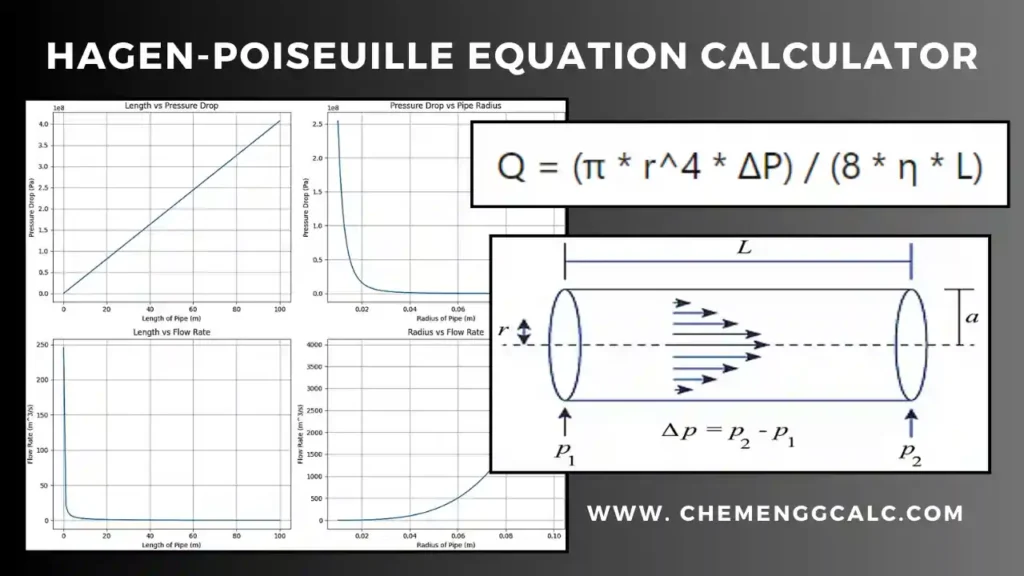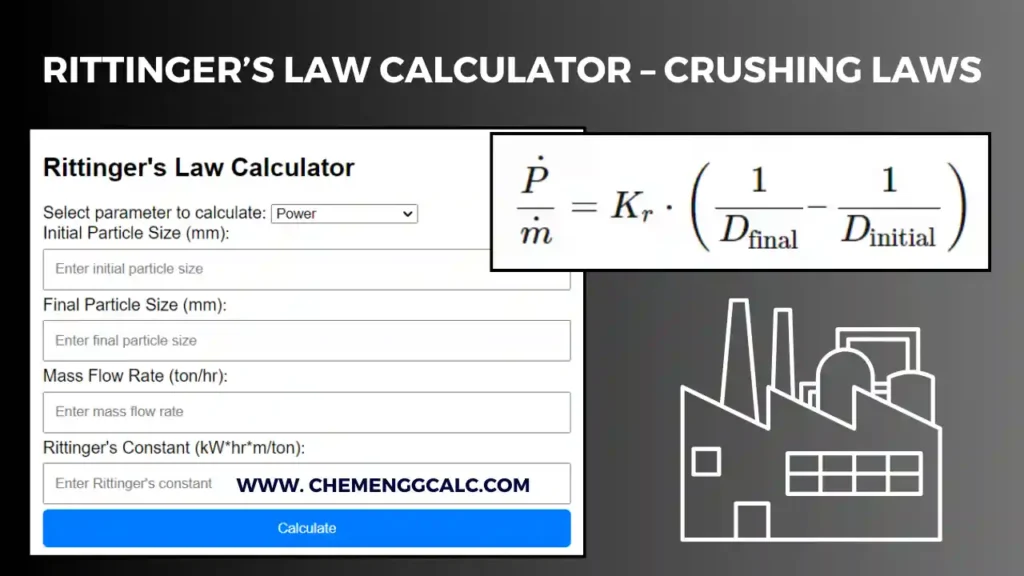Table of Contents
In fluidization, where solid particles are suspended by an upward flow of fluid, minimum fluidization velocity and ergun equation are useful in designing to study the operating condition based on pressure drop across the bed.
Fluidized bed reactor has many applications in industries like chemical processing, pharmaceuticals, and power generation, where they are used for catalytic reactions, combustion, drying, and coating processes due to their excellent heat and mass transfer properties.
Related: Sphericity Calculator for different shapes
What is Minimum Fluidization Velocity
The minimum fluidization velocity, Umf is the lowest fluid velocity at which solid particles in a packed bed start to lift and become suspended in the fluid, initiating fluidization.
The term fluidization and fluidized bed are used to describe the condition of fully suspended particles, since the suspension behaves like a dense fluid. Mathematically it is explained from ergun equation as:
\[(\rho_p – \rho_f) \, g = \frac{150 \, \mu_f \, V_{mf} \, (1 – \epsilon_{mf})}{\phi_s^2 \, D_p^2 \, \epsilon_{mf}^3} + \frac{1.75 \, \rho_f \, V_{mf}^2}{\phi_s \, D_p \, \epsilon_{mf}^3}\]
where in S.I unit:
- ρ is the density of particles (kg/m³)
- ρf is the density of fluid (kg/m³)
- g is the acceleration due to gravity (m/s²)
- μf is the dynamic viscosity of the fluid (Pa·s or kg/(m·s))
- Vmf is the minimum fluidization velocity (m/s)
- ϵmf is the Porosity or void fraction at minimum fluidization (dimensionless)
- ϕs is sphericity of the particles (dimensionless)
- Dp is the average diameter of particles (m)
Related: Ergun Equation Calculator for Pressure Drop in Packed Bed Column
At minimum fluidization velocity, the upward drag force exerted by the fluid flow on each particle balances the particle’s effective weight i.e
Drag force + Buoyant force = Weight of particles
Mathematically, pressure drop per unit length of the bed is written as:
\[\frac{\Delta P}{L} = (1 – \epsilon_{mf}) \cdot (\rho_p – \rho_f) \cdot g\]
where, ΔP/L = pressure drop per unit length of the bed.
Related: Head Loss or Pressure Loss Calculator using Darcy-Weisbach Equation
Minimum Fluidization Velocity Calculator
This Minimum Fluidization Velocity Calculator and Ergun Equation for Fluidized Bed helps user to calculate the pressure drop across fluidized bed, minimum fluidization velocity and reynolds number. User can input the desired values of particle sphericity, diameter, density, bed porosity, gas flow rate, gas density, viscosity and column dimensions.
Note: Value of Bed Porosity at minimum fluidization (Vmf) is different due to bed expansion (For ease we have taken same by default, user can put of it own choice). Click here for commonly used Sphericity values .
Related: Hagen-Poiseuille Equation Calculator / Poiseuille’s Law Solver
Related: Newton’s Law of Viscosity Calculator – Dynamic Viscosity
Condition for Fluidization
- When a liquid or gas at low velocity passed through a bed of solids the particles do not move and the pressure drop across it is given by Ergun Equation.
- If the fluid velocity is steadily increased the pressure drop and drag on individual particle increases, the particle get suspended and reaches a critical velocity, called the minimum fluidization velocity Vmf.
- The particles starts lifting and become suspended, changing the bed from a fixed state (where particles are stationary) to a fluidized state (where particles are fully suspended and behave like a fluid).

Derivation for Minimum Fluidization Velocity
The minimum fluidization velocity, Vmf is the superficial velocity at which a packed bed of particles begins to fluidize. To derive this from the Ergun equation, we equate the pressure drop required to suspend the particles to the weight of the particles per unit area.
At this velocity, the drag force exerted by the fluid on the particles plus the bouyant force equals the weight of the bed.
Weight of Bed = mass of particles x g
mass of particles (bed) = Vparticles x ρp = A x L x (1−ϵ) x ρp
therefore, weight of bed = A x L x (1−ϵ) x ρp x g
Since the bed is submerged in a fluid, the fluid exerts a buoyant force on the particles. Buoyant force is equivalent to the weight of the fluid displaced by the particles, which is:
Buoyant force = volume of particles × density of fluid × g
therefore, bouyant force = A x L x (1−ϵ) x ρf x g
The effective weight of the particle bed, accounting for buoyancy, is then
Effective Weight of bed = A x L x (1−ϵ) x (ρp – ρf ) x g
The pressure drop per unit length ΔP/L is the force per unit area to support the weight of the particles:
\[\frac{\Delta P}{L} = \frac{\text{Effective Weight}}{A}\]
\[\frac{\Delta P}{L} = (1 – \epsilon) \cdot (\rho_p – \rho_f) \cdot g\]
This equation represents the gravitational force per unit area is balanced by the fluid’s upward force (drag).
using ergun equation and replace the value of ΔP/L and equating the same, we get:
\[\frac{\Delta P}{L} = \frac{150 \, \mu \, (1 – \epsilon)^2 \, v}{\epsilon^3 \, d_p^2 \, \phi^2} + \frac{1.75 \, \rho \, (1 – \epsilon) \, v^2}{\epsilon^3 \, d_p \, \phi} \]
The superficial velocity (v) which appears in viscous term having linear dependence and as v2 in the inertial term having quadratic dependence with the pressure drop.
dividing by (1- ϵ) both sides, we get expression for Vmf
\[(\rho_p – \rho_f) \, g = \frac{150 \, \mu_f \, V_{mf} \, (1 – \epsilon_{mf})}{\phi_s^2 \, D_p^2 \, \epsilon_{mf}^3} + \frac{1.75 \, \rho_f \, V_{mf}^2}{\phi_s \, D_p \, \epsilon_{mf}^3}\]
This expression allows you to calculate the minimum fluidization velocity for a given system.
Related: Stoke’s Law Calculator for Terminal Velocity – Derivation and Python Code
Related: Friction Factor Calculator Moody’s Diagram for Smooth and Rough Pipes
Related: Bernoulli’s Equation Calculator / Solver – Interactive Python Code
Example Problem on Fluidization
A bed of ion-exchange beads 8 ft deep is to be backwashed with water to remove dirt. The particles have a density of 1.24 g/cm³ and an average size of 1.1 mm. What is the minimum fluidization velocity using water at 20°C, and what velocity is required to expand the bed by 25 percent? The beads are assumed to be spherical (Φₛ = 1), and εₘ is taken as 0.40.
Given Data:
- μ (viscosity) = 0.01 P
- Δρ (density difference) = (1.24 – 1) = 0.24 g/cm³
- d (particle size) = 0.11 cm
- Φₛ (sphericity) = 1
- εₘ (void fraction at minimum fluidization) = 0.40
Required:
- Minimum fluidization velocity Vmf using water at 20°C.
- Velocity V0 to expand the bed by 25%.
using equation for solving minimum fluidization velocity:
\[(\rho_p – \rho_f) \, g = \frac{150 \, \mu_f \, V_{mf} \, (1 – \epsilon_{mf})}{\phi_s^2 \, D_p^2 \, \epsilon_{mf}^3} + \frac{1.75 \, \rho_f \, V_{mf}^2}{\phi_s \, D_p \, \epsilon_{mf}^3}\]
putting the given values, we get, left hand side is 980(0.24) and the right hand side is:
\[= \frac{150(0.01)(0.6)V_{mf}}{(0.11)^2(0.4)^3} + \frac{1.75(1.0)(1)(V_{mf})^2}{0.11 (0.4)^3}\]
\[1162 V_{0M} + 248.6 V_{0M}^2 = 235.2\]
for ease of calculation, we will solve this quadratic equation using python code given below:
import math
# Given data
mu = 0.01 # viscosity in P (poise)
delta_rho = 0.24 # density difference in g/cm^3
d = 0.11 # particle size in cm
epsilon_M = 0.40 # void fraction at minimum fluidization
# Step 1: Solve for V_mf using the quadratic formula
# Coefficients for the quadratic equation to find V_mf
a = 248.6
b = 1162
c = -235.2
# Calculate the discriminant
discriminant = b**2 - 4 * a * c
# Check if discriminant is non-negative to ensure real solutions
if discriminant >= 0:
V_mf_positive = (-b + math.sqrt(discriminant)) / (2 * a)
V_mf_negative = (-b - math.sqrt(discriminant)) / (2 * a)
# Choose the positive solution for velocity
V_mf = V_mf_positive if V_mf_positive > 0 else V_mf_negative
else:
V_mf = None
print("No real solutions for V_mf.")
# Display V_mf in cm/s and mm/s
V_mf_cm_s = V_mf # in cm/s
V_mf_mm_s = V_mf * 10 # in mm/s
# Step 2: Calculate Reynolds number at V_mf
Re_p = (d * V_mf * 1.24) / mu # assuming density of particles is 1.24 g/cm^3
# Step 3: Calculate V_0 for 25% bed expansion
epsilon_expanded = 0.52
V_0 = V_mf * (epsilon_expanded / epsilon_M)**3.9 # expanded velocity in cm/s
# Display results
print(f"Minimum fluidization velocity, V_mf: {V_mf_cm_s:.3f} cm/s or {V_mf_mm_s:.3f} mm/s")
print(f"Reynolds number at V_mf: {Re_p:.2f}")
print(f"Velocity for 25% expansion, V_0: {V_0:.3f} cm/s or {V_0 * 10:.3f} mm/s")Output:
Minimum fluidization velocity, V_mf: 0.194 cm/s or 1.943 mm/s
Reynolds number at V_mf: 2.65
Velocity for 25% expansion, V_0: 0.541 cm/s or 5.407 mm/sRelated: Screen Analysis – Differential and Cumulative Distribution
Related: Rittinger’s Law Calculator
Related: Kick’s Law Calculator
Edition: 9th Edition, By: Don W. Green, Marylee Z. Southard
The ultimate resource for chemical engineering, covering core concepts, data, and insights. An invaluable reference for students, engineers, and industry professionals.
Buy on AmazonResources:
- “Unit Operations in Chemical Engineering” (McCabe et al.)
- “Particle Technology and Separation Processes” (Richardson et al.)
- “Chemical Engineering Design: Principles, Practice and Economics of Plant and Process Design” (Towler and Sinnott)
- “Fluid Mechanics: Fundamentals and Applications” by Çengel and Cimbala
Disclaimer: The Solver provided here is for educational purposes. While efforts ensure accuracy, results may not always reflect real-world scenarios. Verify results with other sources and consult professionals for critical applications. Contact us for any suggestions or corrections.








